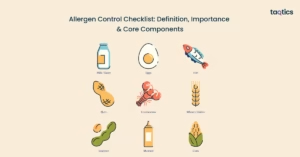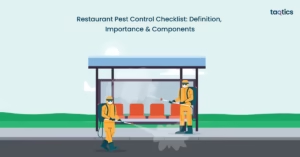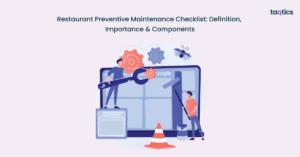How to Conduct a Comprehensive Food Safety Audit in Your Restaurant?

Maintaining good food safety standards in your restaurant business should be a top responsibility. Conducting detailed audits of your buildings, supplies, staff, and processes regularly is critical for correcting any flaws and ensuring compliance with food safety standards. However, it is confusing where to start the restaurant audit process. Nonetheless, restaurants can decrease risk, assure compliance, and safeguard their customers’ health by following the best food safety audit practices.
Without any further ado, let’s jump on what a food safety audit is and how restaurants can conduct the audits in a strategic and structured manner.
What is a food safety audit?
A food safety audit is a highly structured activity that aims to document the evaluations of a restaurant’s or food business’s food safety management system. Food safety audits are essential because consumers are becoming more aware of food safety laws and regulations and the risk of food contamination. Besides, food safety agencies heavily emphasize hazard analysis and prevention to protect public health. It provides all the more reason to strengthen your food safety management system before any chaos arises.
Now, verifying the level of the food safety management system is not the only objective of the food audit. Let’s understand the other objectives:
- Certification audit for certain food safety standards
- Assessment of premises condition and business performance
- Legal compliance assurity
- Inspection in response to a complaint
- Food supplier request
- Regulatory requirement
What are the types of food safety audits?
A food safety audit creates a transparent report about the situation and level of food safety systems in the facility. The report helps assess the gaps and bridges them to improve the food safety management system. Usually, food safety audits are categorized into two types: internal and external.
An internal audit is conducted by experienced food safety professionals or managers within the food business. Meanwhile, external audits are conducted by second or third-party organizations.
Besides, the food safety audits can be further subdivided into three types based on the relationship between the auditor and the food business that is in question. Let’s understand all three types of food safety audits.
1. First-party audit
The employees of the food business conduct first-party audits to evaluate their food safety systems. It is performed on a regular basis and identifies points for improvement. It is also essential to ensure food safety compliance and readiness for any external audit.
2. Second-party audit
A second-party audit, also called a proprietary audit, is conducted by the food business, primary organization, or other business directly related to the food business, like a food supplier. It is conducted to ensure the suitability of a new or existing supplier through the effectiveness of food safety management systems.
3. Third-party audit
Independent auditors and food auditing firms conduct third-party audits to perform a complete assessment of the food management systems and operation status. It is commonly conducted to acquire a certification or satisfy new regulatory requirements.
Why are food safety audits important?
Food safety audits play a critical role in maintaining food businesses’ reputation in the market, besides ensuring the safety and quality of food. Let’s understand the reasons that make food safety audits important.
- Verify adherence to mandatory regulations.
Consistent food safety assessments are of the utmost importance in guaranteeing that food businesses conform to the pertinent legislation, regulations, and benchmarks established by food safety governing bodies and authorities. Audits serve to validate that businesses are adhering to mandatory food safety regulations and implementing appropriate protocols. This practice upholds confidence and safeguards public health within the food industry.
- Instill a food safety culture.
The implementation of regular internal and external food safety audits has the potential to improve an organization’s food safety culture greatly. Audits provide the employees the chance to receive training on appropriate food safety protocols. Consistent audits ensure that food safety remains paramount and foster an ongoing commitment to enhancing food handling protocols.
- Pinpoint gaps and opportunities for improvement.
Thorough food safety audits, whether performed internally or by an external firm, are crucial for identifying improvement opportunities. Audits conduct thorough assessments of current performance, current compliance, and best practices to identify any deficiencies or vulnerabilities in an establishment’s food safety program. The audit results enable firms to better their policies, procedures, training, and operations by taking remedial steps.
- Boost customer confidence and loyalty.
Restaurants that are subjected to audits in order to ensure conformance to food safety regulations and fulfil customer expectations commonly observe an enhancement in levels of customer satisfaction. Customers are instilled with a sense of confidence and assurance in a business that demonstrates a steadfast commitment to food safety through the transparent disclosure of audit results.
Preparation for the food safety audit
Preparation for a food safety audit requires a comprehensive strategy and solid checklist, whether an internal team or an external firm conducts it. Let’s understand how businesses can prepare for food safety audits:
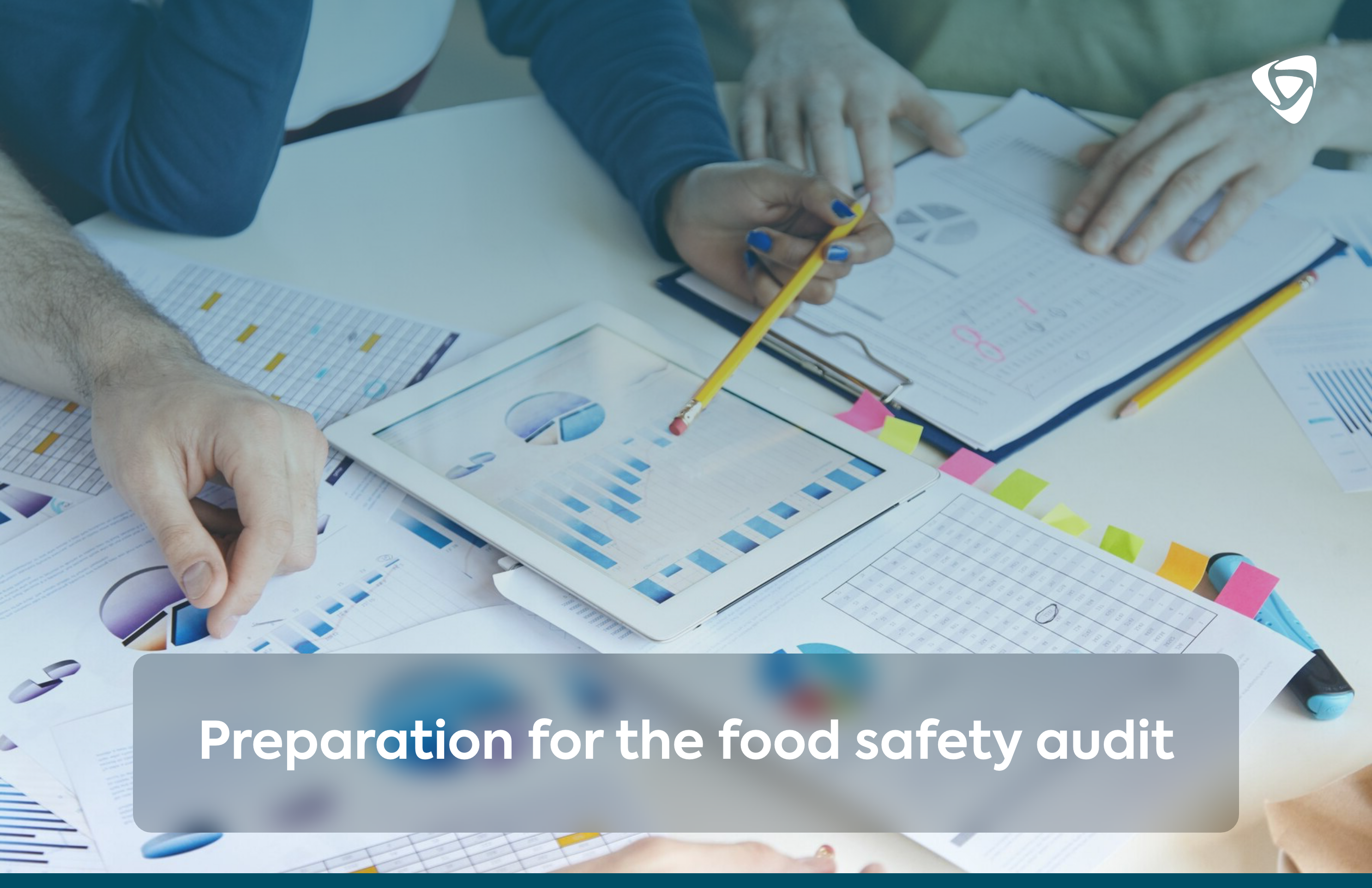
Creating a checklist of essential items and areas to be audited
Compile an exhaustive inventory of all critical areas, processes, documentation, equipment, facilities, and products that require meticulous examination well in advance of the audit. By utilizing the protocol, the audit is standardized across all locations, and no essential component is guaranteed to be neglected. The food safety audit checks and inspects the following areas:
- Food safety management system
- Food storage
- Food preparation
- Sanitation and cleaning
- Facility design
- Waste management
- Employee hygiene
Assembling a team responsible for conducting the audit
Strictly choose auditors on the basis of their knowledge and proficiency in food safety protocols, regulatory obligations, inspection methodologies, and the particular equipment and operations of your establishment. Accredited third-party auditors or internal staff can perform unbiased external audits. Set the audit criteria, scope, and team members’ obligations. Make sure auditors are trained in interviewing, recording non-conformities, applying the process, and watching operations.
Ensuring all staff members are trained in food safety protocols.
Check that all employees have received proper food safety training in the weeks preceding the audit. Conduct regular refresher lessons on food handling, preparation, chilling, storage, sanitization, pest control, and waste management. Inform employees of the upcoming audit and clarify their responsibilities about the procedure. It is imperative to patch any deficiencies in training in order to fortify food safety practices and knowledge. Document all training activities.
Steps to conduct the food safety audit
Here are the steps businesses should perform to conduct the food safety audit properly.
Inspection of kitchen cleanliness
Ensure clean floors, walls, ceilings, sinks, countertops, and backsplash. Check for food particles, moulds, grease, and other sanitary concerns. Ensure that the schedule has sanitized all surfaces and that the logs are recent. Assess the effectiveness of personnel cleansing procedures, substances, equipment, and methods. Ensure that chemicals and sanitizers are stored appropriately.
Proper food storage practices
Ensure that the temperature control and monitoring of dry storage shelves, refrigerators, and freezers are all in pristine condition. Examine food labelling and stock rotation procedures for expiration dates. Store raw meats, vegetables, and ready-to-eat meals correctly to avoid cross-contamination. Safely keeping food six inches above the floor and away from contamination is crucial. Evaluate the flow and organization of storage areas.
Food handling and preparation procedures
Cast a watchful eye on the culinary personnel as they prepare food. Verify proper handwashing, glove use, hairnet, and uniform rules are consistently followed. Assess the potential for cross-contamination and temperature abuse. Verify that personnel are employing calibrated thermometers and respecting time/temperature control regulations. Examine the thawing, washing, marinating, chilling, and other activities.
Equipment maintenance and hygiene
Check all culinary and food preparation equipment for appropriate functioning, sanitation, upkeep, and arrangement. Check equipment maintenance and calibration according to schedules and records. Inspect for signs of deterioration, accumulation, erosion, or other complications. Ensure that procedures for cleansing equipment are consistently adhered to. Assess maintenance records.
Staff hygiene
Handwashing, jewellery, hair/beard restraints, nail maintenance, cuts/wound care, health policies, and other personal hygiene practices exhibited by employees should be thoroughly assessed. Confirm that there are no indications of illness—interview personnel and review training records to ensure that they have a solid understanding of the policies. Evaluate the breakroom and restroom facilities for employees.
Pest control measures
Inspect for signs of insect infestation, such as droppings or nests. Check bait stations, traps, and monitors are properly located. Confirm compliance with chemical storage and pest management policies. Corrective actions and treatment reports should be reviewed. Verify that all doors, windows, and pipelines are sealed appropriately.
Food safety audit checklist
Let’s look at the food safety audit checklist to ensure that you are properly prepared for the food safety audit.
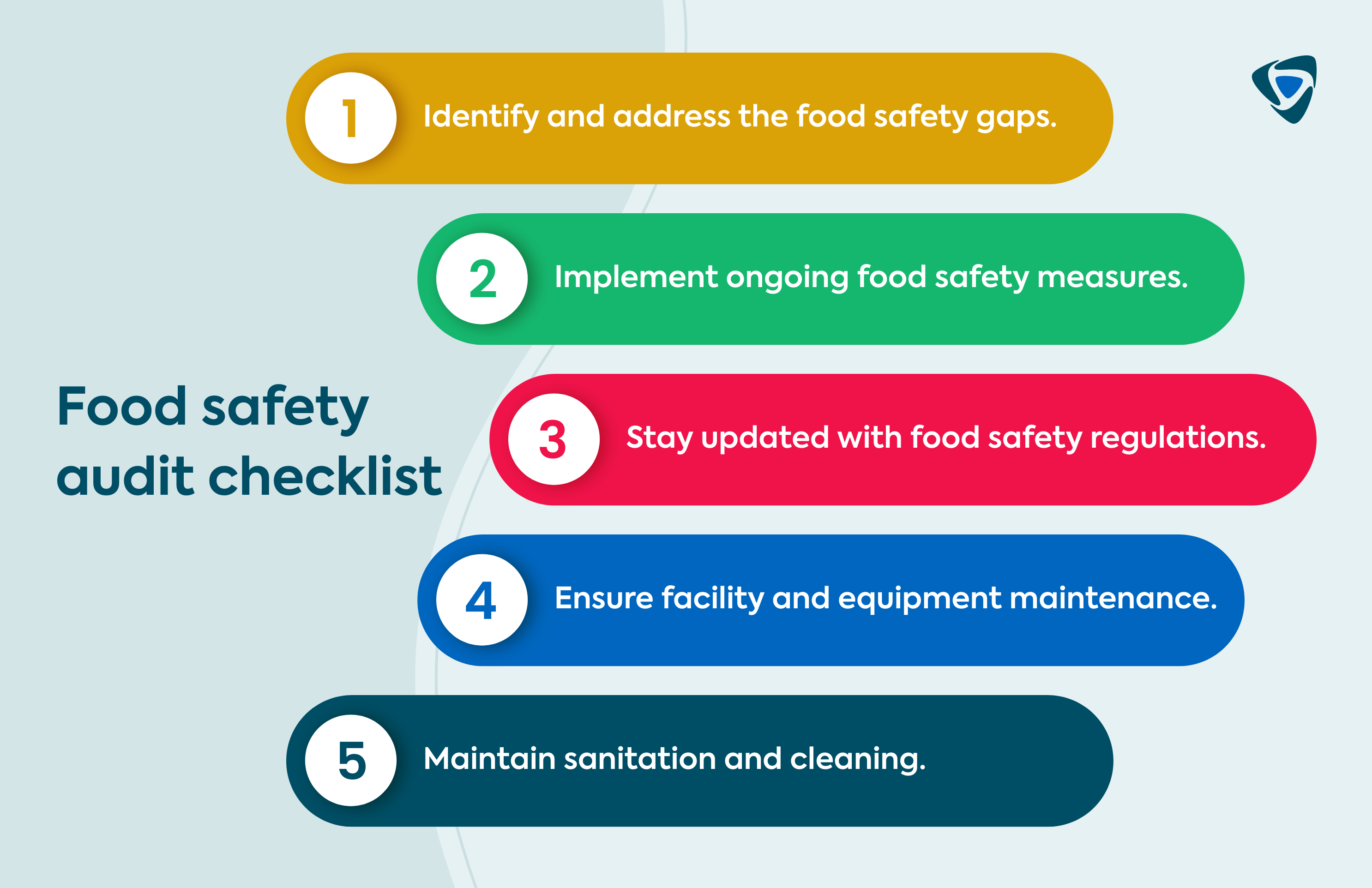
Identify and address the food safety gaps.
Regular food safety assessments assist in the detection of potential food safety deficiencies, non-compliances, and gaps in the policies, processes, staff conduct, or facilities of an establishment. Third-party evaluations and internal cross-departmental assessments offer an impartial standpoint to identify specific areas that require enhancement.
Upon the identification of deficiencies, it is essential to promptly implement corrective measures such as retraining personnel, upgrading equipment, improving documentation, or revising food safety plans. It is essential to maintain vigilance and view audit findings as opportunities for growth.
Implement ongoing food safety measures.
A strong food safety culture necessitates that all operations maintain constant vigilance. A deeply embedded organizational mentality propels this, in addition to extensive training initiatives. Implementing routine food safety training exercises ensures that employees remain current with the most recent scientific protocols and prevents any loss of knowledge.
Frequent drills should be conducted to reinforce proper hand hygiene, sanitation protocols, and contamination prevention measures. The implementation of emerging technologies such as digital monitoring systems, predictive analytics, and temperature control tools facilitates enhanced regulatory compliance and real-time oversight.
Stay updated with food safety regulations.
As new risks arise, regulating organizations’ food safety legislation, guidelines, and industry standards are continually improving. It is critical to remain current by monitoring websites, publications, training seminars, and regulatory notifications. Joining industry groups, attending workshops, and appointing regulatory liaisons all assist firms in staying up to speed on the newest Hazard Analysis and Critical Control Points (HACCP) principles, reportable diseases, allergy labelling, and other key needs.
Ensure facility and equipment maintenance.
Evaluate the sanitation and adequacy of facilities, including the organization, light, layout, ventilation, and maintenance of preparation surfaces, sinks, storage areas, and restrooms. Ensure the hygiene and condition of all food-contact items, utensils, machinery, and equipment. Surface swabs are tested for microbiological levels. Verifying equipment records, calibration, and maintenance, including temperature monitoring devices, pH meters, and thermometers.
Maintain sanitation and cleaning.
Evaluate the adequacy of cleaning procedures for food preparation and storage areas, tools, utensils, and surfaces, including methods, frequencies, tools, chemicals, concentrations, equipment, and PPE usage. Verify the availability of a three-compartment basin of commercial quality, equipped with hot water, drying racks, brushes, and chemical/sanitizer supplies to facilitate the cleaning, rinsing, and sanitization of kitchenware. Conduct maintenance and cleansing records inspections to verify consistent adherence to sanitation procedures.
Benefits of a successful food safety audit
A good food safety audit may increase a restaurant’s reputation, customer trust, and revenue. Clean audits demonstrate to customers that the firm values hygiene and food safety. It shows that the restaurant is open to third-party observation for public health and has nothing to hide. Customers feel confident eating since strict food safety laws are followed.
In today’s digital age, restaurant reviews and social media build a business’s reputation. A restaurant may promote a flawless audit to boost its brand and competitiveness. It fosters trust in the kitchen’s hygiene, the dining experience’s safety, and the food quality.
Successful audits can assist chains and franchises in attracting new franchise partners who seek confirmation that the brand conforms to rigorous food safety protocols. Additionally, supplier relationships are strengthened by the fact that audits verify the correct handling of raw materials and ingredients.
Successful audits validate the effectiveness of systems and training on an internal level. These individuals provide authority to staff members to implement appropriate protocols and uphold an organization-wide ethos of food safety. Opportunities for ongoing enhancement and strengths that require further development can be identified by management.
What is Restaurant Operations Management?
Restaurant operations management involves overseeing everyday operations and business procedures for effective management. It involves managing staffing, inventory, purchasing, budgeting, food expenses, quality control, safety, and restaurant operations, both front and back. Using resources efficiently maximizes production, revenue, food quality, and service.
Collaboration among teams, business acumen, applying tools and technology, and leadership are all essential components of effective operations management. It consists of establishing protocols, evaluating performance, and implementing corrective measures as necessary. Effective operations management enables dining establishments to fulfill their goals, provide exceptional customer experiences, and motivate employees.
Restaurant Operations Checklist
Here are the main restaurant operations checklists:
- Ensure adequate staffing levels for projected sales and guests
- Create schedules to cover all shifts and peak periods properly
- Track employee hours and labor costs
- Maintain proper inventory levels on hand
- Place orders with vendors/suppliers as needed
- Log deliveries and check the quality of ingredients
- Conduct regular inventory counts and audits
- Follow cleaning schedules and logs
- Monitor temperatures of refrigerators, freezers, food
- Ensure prep, service, and cleaning procedures are followed
- Conduct pest control measures
- Perform preventative maintenance on all equipment
- Check the calibration and function of thermometers
- Monitor and address guest feedback
- Maintain accurate order-taking and fulfilment
- Maintain facility aesthetics and atmosphere
This comprehensive checklist will help you and your restaurant business to ensure that your operations are executed smoothly, and if there are any gaps in the operation that affect your efficiency, you can take timely action to improve and bridge the gap.
Conclusion
For any restaurant, the implementation of a comprehensive food safety surveillance program is an essential investment. Audits ensure the safety of food for human consumption by providing independent verification that your facilities, equipment, processes, and employees comply with regulatory requirements and stick to appropriate protocols.
Regular audits serve the purpose of identifying potential areas for enhancement, reinforcing safety protocols, and safeguarding both the business and its customers. Maintain awareness of evolving regulations and allocate resources to continuous staff training.
Your audits will give useful insights to enhance operations with careful planning, rigorous execution, rapid action on findings, and a firm commitment to food safety from the top down. A proactive approach to audits reflects your unwavering dedication to providing safe, high-quality meals to guests every day.

